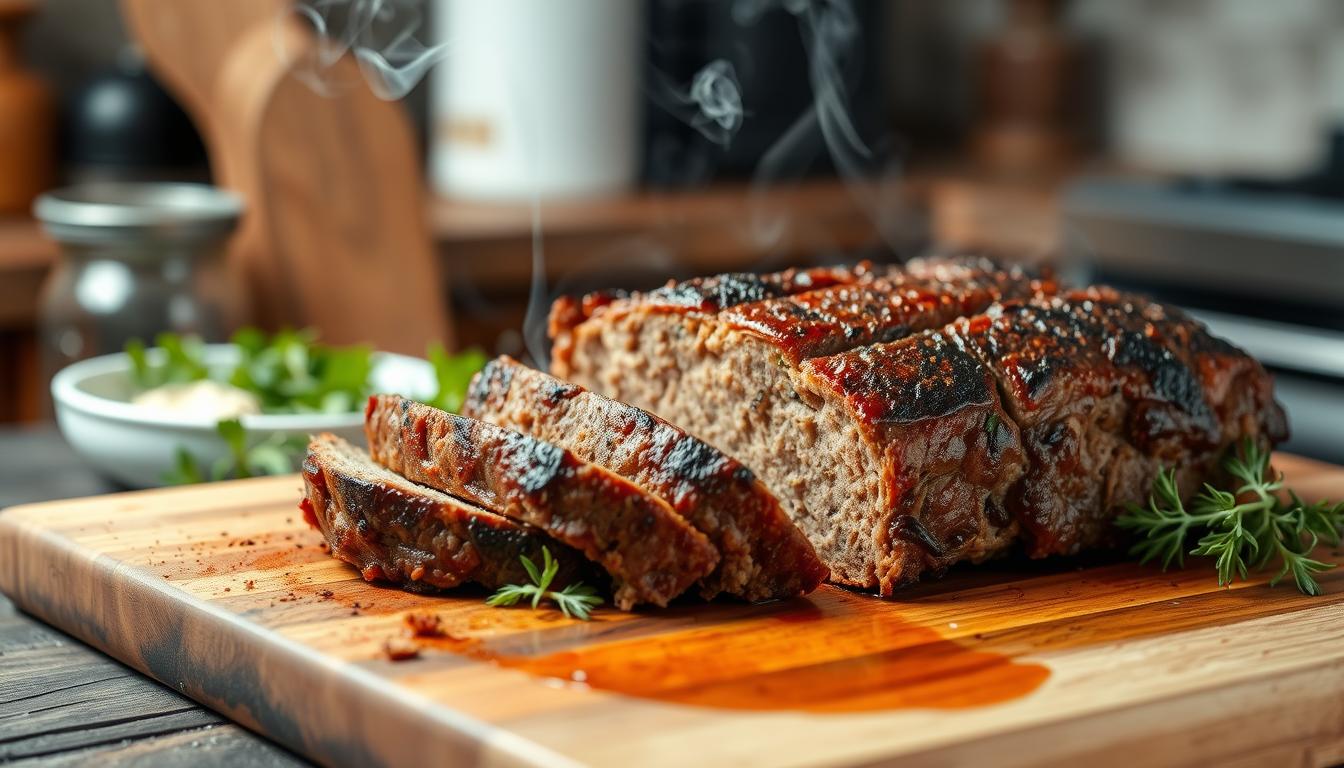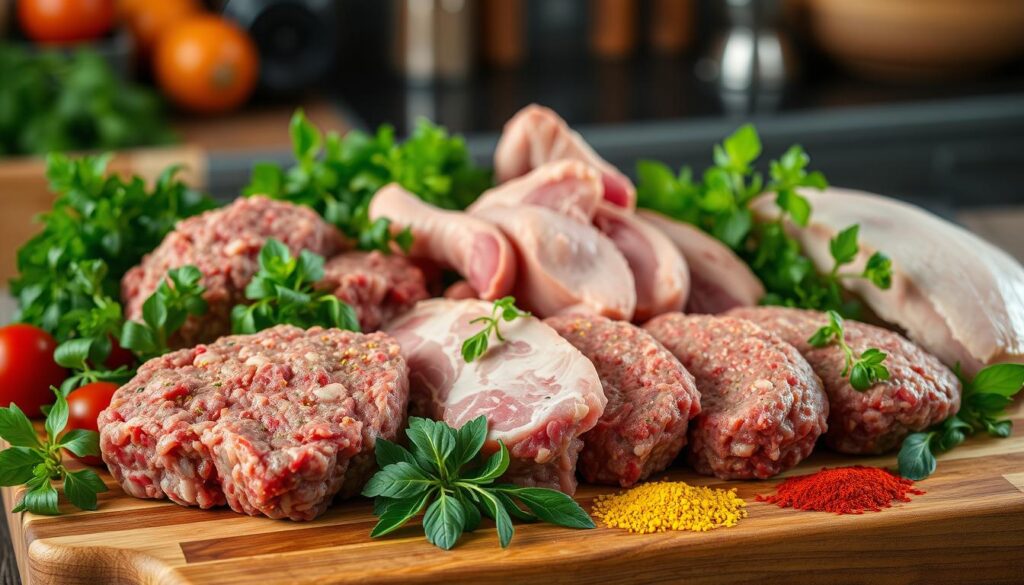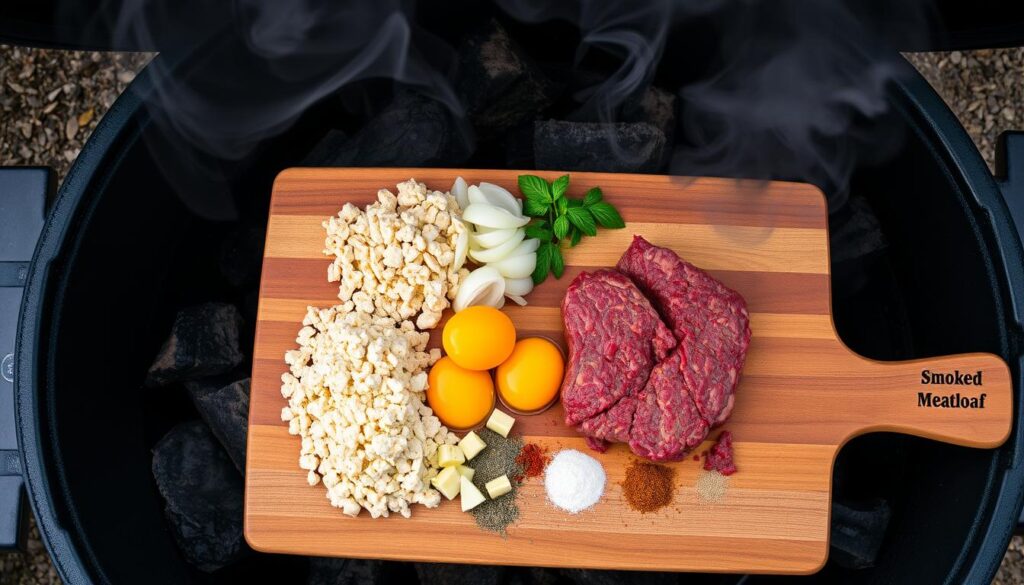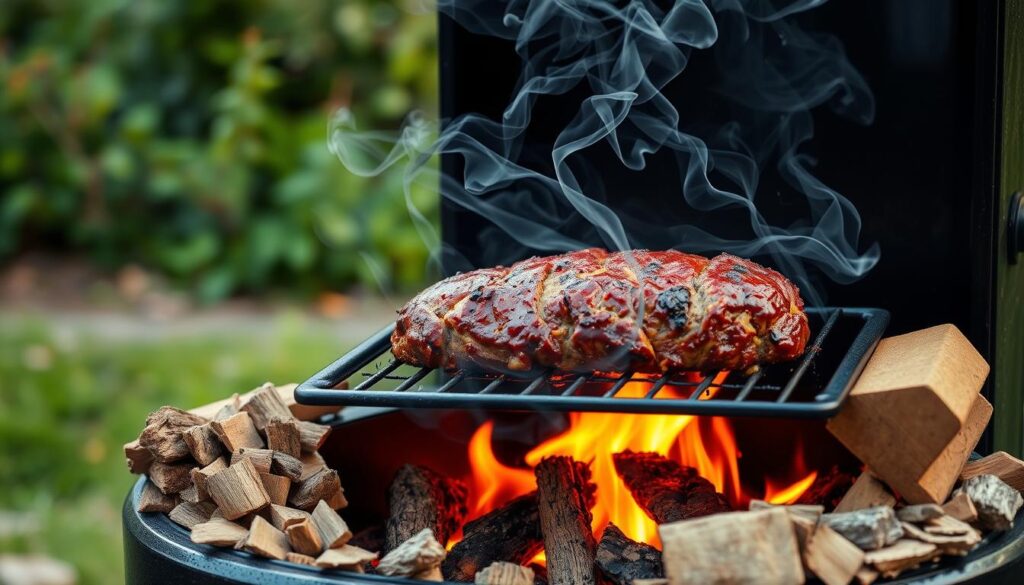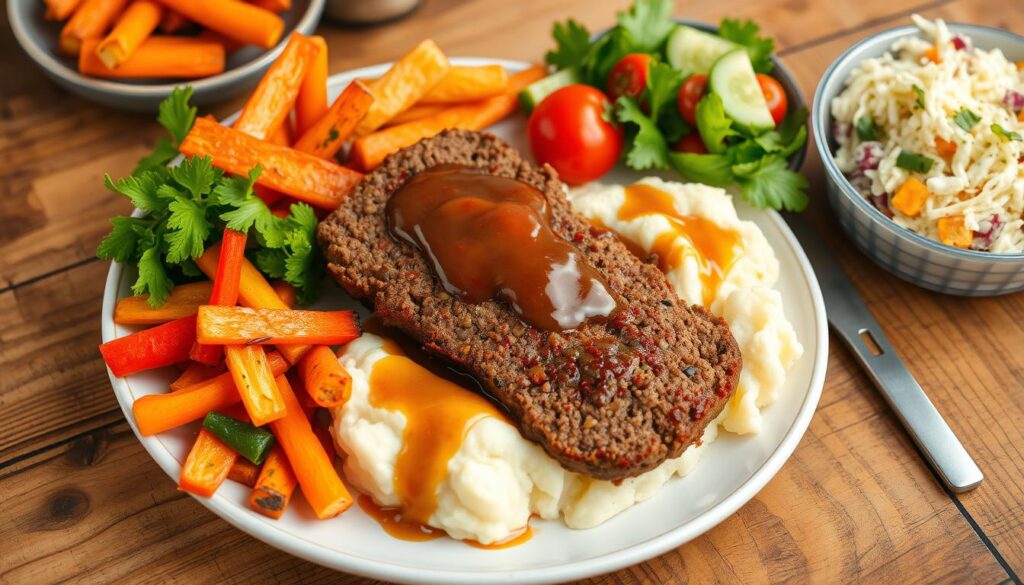The smell of smoke fills the backyard, and the sizzle of a smoked meatloaf is heard. It’s not just a meal; it’s a special experience. It turns a simple dinner into something amazing. This recipe will be your go-to for weekend meals. Smoking meatloaf is an art that adds deep flavors to each bite. It uses 80/20 ground beef and the right spices. This recipe offers a delicious journey, unlike traditional blue rare steak.
Picture cutting into a smoked meatloaf and seeing a tender inside with a smoky outside. It’s not just about ingredients; it’s about making a memorable meal. It brings people together, celebrating flavor and skill.
Are you ready to make a smoked meatloaf that everyone will love? We’ll show you how to pick the best meat and smoke it perfectly. Follow our guide to create a dish that will impress everyone.
Introduction to Smoked Meatloaf
Meatloaf is a classic in American cooking, but smoking makes it gourmet. This upgrade will excite your taste buds and wow your guests.
The Origins of Meatloaf History
Meatloaf’s roots go back to ancient Rome. But it became a favorite in America during the Great Depression. Families made it with ground meat to stretch their food. Now, smoked meatloaf takes this dish to new heights.
- Ancient Roman recipe origins
- Great Depression popularity
- Modern gourmet reinvention
Why Smoke Your blue rare steak?
Smoking does more than just cook. It adds deep, rich flavors that regular cooking can’t. This method makes your meatloaf tender and full of flavor, making everyone want seconds.
| Smoking Method | Flavor Intensity | Cooking Time |
|---|---|---|
| Oak Wood Chips | Medium | 2-3 hours |
| Hickory Wood Chips | Strong | 2-3 hours |
| Apple Wood Chips | Light | 2-3 hours |
Key Differences Between Grilled and Smoked Meatloaf
Smoking is different from grilling. It keeps the meat moist and adds complex flavors. The slow cooking lets smoke deeply penetrate, making a simple meatloaf into a special dish.
“Smoking is not just cooking, it’s an art form that turns simple ingredients into memorable meals.”
Start your smoked meatloaf journey here. Get ready to change your cooking and impress your family with these amazing techniques!
Understanding Blue Rare Steak
Blue rare steak is a culinary adventure that pushes the limits of cooking. It’s about keeping the steak’s natural taste and texture. This method is all about minimalism.
What is Blue Rare Steak?
Blue rare steak is a bloody steak with a red center. It’s cooked for just a minute or two on each side. This quick cooking keeps the inside almost raw.
Nutritional Benefits of Blue Rare Steak
Blue rare steak has many health benefits:
- It keeps more protein
- It saves nutrients lost in long cooking
- It offers a raw taste with less nutrient loss
“Blue rare steak allows the true quality of premium cuts to shine through without masking their natural characteristics.” – Culinary Expert
Cooking Techniques for Blue Rare Steak
Getting the perfect seared steak needs skill. The best cuts are:
- Tenderloin
- Flat Iron
- Sirloin Tip
Important cooking details include:
| Characteristic | Specification |
|---|---|
| Cooking Time | 1-2 minutes per side |
| Internal Temperature | 115 degrees Fahrenheit |
| Safe Consumption Temperature | 145°F |
Pro tip: Always source high-quality, fresh meat from reputable suppliers to ensure safety when preparing blue rare steak.
Essential Ingredients for Smoked Meatloaf
Creating a delicious smoked meatloaf starts with the right ingredients. Your journey begins with mixing flavors and choosing top-notch components. This turns a simple dish into a memorable meal.
High-Quality Ground Meat Choices:
Choosing the right meat is key for your meatloaf. For a juicy texture, pick ground beef with 80/20 or 85/15 fat content. This ratio gives your meatloaf a tender steak-like feel.
- Ground chuck (recommended for rich flavor)
- Ground beef (80/20 fat content)
- Ground pork (for added complexity)
- Wild game options like elk or venison
Spices and Seasonings for Flavor: blue rare steak
Enhance your meatloaf with the right spices for depth and complexity. A premium cut steak-inspired approach means layering flavors carefully.
- Worcestershire sauce
- Garlic powder
- Salt and black pepper
- Jack Daniels whiskey (optional)
“The right blend of spices can transform a simple meatloaf into a culinary masterpiece.”
Optional Add-Ins to Enhance Taste: blue rare steak
Make your meatloaf stand out with creative add-ins. Try different ingredients to make your recipe unique.
- Crispy bacon bits
- Pepper jack cheese
- Cheddar cheese
- Sautéed onions and green peppers
The secret to a great smoked meatloaf is balancing ingredients. Let each part shine. Your creativity in the kitchen will make the difference.
Preparing Your Smoked Meatloaf: blue rare steak
Making the perfect smoked meatloaf needs careful preparation and mixing skills. It’s all about how you handle your ingredients and shape the meatloaf. This is what makes a dish truly stand out.
Mastering Mixing Techniques: blue rare steak
When making your meatloaf, keep these mixing tips in mind:
- Use cold ingredients for better binding
- Mix gently to prevent tough texture
- Avoid overworking the meat mixture
Perfect Shaping Strategies: blue rare steak
Shaping meatloaf is an art that needs focus. Start by:
- Spreading meat mixture evenly on a flat surface
- Creating a uniform thickness
- Ensuring compact but not dense formation
“The secret to a great meatloaf is in the gentle touch and careful preparation.” – Professional Chef
Texture Tips for Exceptional Results: blue rare steak
For the perfect texture, follow these expert tips:
- Use fresh breadcrumbs for moisture
- Include eggs as a binding agent
- Rest the mixture before final shaping
Remember, making a great meatloaf is about balance, technique, and patience. Take your time, and you’ll make a smoky, delicious masterpiece. It will surely impress everyone at the table.
The Smoking Process Explained: blue rare steak
Smoking meatloaf is an art that turns a simple dish into a masterpiece. The right mix of wood chips, smoking temperature, and cooking time makes a big difference. It can take your meatloaf from good to amazing.
Selecting the Perfect Wood Chips: blue rare steak
Choosing the right wood chips is key to great flavor. Each wood type gives your meatloaf a unique taste:
- Mesquite: Intense, bold flavor
- Oak: Mild and versatile
- Pecan: Sweet and nutty undertones
- Cherry: Subtle fruity essence
- Hickory: Classic smoky taste
Mastering Smoking Temperature: blue rare steak
Keeping the temperature right is crucial. Aim for 225-240 degrees Fahrenheit. This keeps your meatloaf cooking evenly and adds rich flavors.
| Wood Type | Flavor Intensity | Recommended Use |
|---|---|---|
| Mesquite | Strong | Short smoking times |
| Oak | Medium | Versatile for most meats |
| Cherry | Light | Excellent for poultry and pork |
Perfecting Meatloaf Cooking Time: blue rare steak
Smoking meatloaf takes time. It usually cooks for about 4 hours. Use a digital thermometer to check the meat’s temperature. Aim for 160 degrees Fahrenheit for safety.
“Smoking is about passion, patience, and precision.” – BBQ Pitmaster
Pro tip: Keep the smoke going for at least 3 hours. This covers about 75% of your cooking time. It ensures your meatloaf gets a deep, smoky flavor that will wow your guests.
Pairing Sides with Smoked Meatloaf: blue rare steak
Enhancing your smoked meatloaf experience is more than just the main dish. The right sides can make your meal unforgettable. Choosing sides with complementary flavors is key to a delightful dining experience.
Classic Sides That Complement Meatloaf
Traditional sides offer comfort and familiarity. Here are classic pairings that bring out the smoky flavor of your meatloaf:
- Creamy mashed potatoes
- Roasted seasonal vegetables
- Green garden salad
- Buttered corn on the cob
Unique Side Dishes to Explore
For a standout meal, try these innovative sides:
- Smoked mac and cheese
- Grilled vegetable medley
- Cauliflower gratín
- Crispy Brussels sprouts with bacon
Beverage Pairings for the Complete Meal
The right drink can make your smoked meatloaf even better. Here are some drink options:
| Beverage Type | Flavor Profile |
|---|---|
| Robust Red Wine | Cabernet Sauvignon, Zinfandel |
| Craft Beer | Amber Ale, Porter |
| Spirits | Bourbon, Whiskey |
“The perfect side dish can turn a good meal into an unforgettable culinary experience.”
Great meal pairing is all about balancing flavors. Your smoked meatloaf’s smoky taste deserves sides that enhance it without overpowering it.
Storing and Reheating Leftover Meatloaf
Keeping your smoked meatloaf fresh is key. Use the right storage methods to enjoy it again and again. This way, you keep its taste and texture just right.
Best Practices for Storage
Here are the top tips for storing your meatloaf:
- Cool the meatloaf to room temperature within two hours of cooking
- Store in airtight containers or wrapped tightly in aluminum foil
- Refrigerate at temperatures between 35°F to 38°F
- Consume refrigerated meatloaf within 3-4 days
Reheating Without Losing Moisture
Reheating is important to keep your meatloaf moist. Here’s how to do it right:
- Preheat oven to 350°F
- Add a splash of broth or water to keep it moist
- Cover with foil to trap steam
- Reheat until internal temperature reaches 165°F
Creative Leftover Recipes
Turn your leftover meatloaf into something new and exciting:
| Leftover Recipe | Preparation Method |
|---|---|
| Meatloaf Sandwich | Slice thinly, serve on toasted bread with lettuce and tomato |
| Meatloaf Pasta Sauce | Crumble and mix into marinara sauce |
| Loaded Potato Topping | Dice and sprinkle over baked potatoes |
“Leftovers are not just repeated meals, they’re opportunities for culinary creativity!” – Home Cooking Enthusiast
Troubleshooting Common Issues
Smoking meatloaf can be tricky, even for experienced cooks. You need to watch out for common cooking problems. These can affect your meatloaf’s taste and texture.
To master smoked meatloaf, you must know how to solve common issues. We’ll look at ways to fix flavor and cooking problems.
Overcooked or Undercooked Meatloaf
Keeping meatloaf moist is key. Here are tips to avoid overcooking:
- Invest in a reliable meat thermometer
- Check internal temperature regularly
- Remove meatloaf when it reaches 160°F
- Let the meatloaf rest for 10-15 minutes after cooking
Adjusting Flavor Profiles
If your meatloaf tastes flat, try these flavor boosts:
- Add fresh herbs like parsley or thyme
- Experiment with different spice combinations
- Use Worcestershire sauce for umami boost
- Incorporate grated onions or garlic for intensity
Fixing Texture Problems
Texture is crucial for a great smoked meatloaf. Here’s how to avoid dryness:
- Mix ingredients gently to prevent compacting
- Use a blend of meats for better moisture
- Include breadcrumbs or crushed crackers for softness
- Consider adding an extra egg for binding
“Great cooking is about understanding ingredients and techniques, not following recipes exactly.” – Unknown Chef
Final Thoughts on Meatloaf Mastery
Making the perfect smoked meatloaf is an art that needs passion and creativity. It’s about finding your own way through different meatloaf recipes. This shows your personal taste and style.
Perfecting Your Personal Recipe
Every chef knows that success comes from trying and learning. In professional kitchens, they found key tips for making meatloaf:
- Use ground beef with 15% fat for the best moisture
- Choose plain dried breadcrumbs for the best binding
- Try chicken stock instead of milk for richer flavor
- Season with a full tablespoon of kosher salt
Experimenting with Variations
Your meatloaf journey should be exciting. Try new things like:
- Using different wood chips for smoking
- Adding unexpected ingredients
- Changing cooking temperatures
- Creating new glazes
“Cooking is an art, and meatloaf is your canvas. Paint with flavors, experiment boldly, and create your masterpiece.”
Sharing Your Smoked Meatloaf Success
Join online BBQ communities to share your recipes. Learn from others and celebrate smoked meatloaf. Your unique recipe might inspire someone else’s next dish.
| Meatloaf Variation | Key Ingredients | Unique Twist |
|---|---|---|
| Classic Beef | Ground beef, breadcrumbs | Traditional smoking technique |
| Spicy Southwest | Ground beef, jalapeños, corn | Chipotle wood chips |
| Mediterranean | Ground lamb, feta, herbs | Olive wood smoking |
Conclusion: Embracing the Art of Meatloaf
Your journey into smoked meatloaf is more than just cooking. It’s a dive into American cuisine’s rich history. Smoking turns this classic dish into a special experience, linking you to home cooks through the ages.
Exploring recipes is about more than following steps. It’s about diving into the flavors and techniques that make American food unique. Your dedication to mastering smoked meatloaf shows your creativity and love for cooking. Every time you try new wood chips, seasonings, or methods, you add to our culinary heritage.
Meatloaf’s beauty is in its flexibility and personal touch. Whether you stick to traditional recipes or add your own twist, you’re part of a tasty cultural story. Keep trying new things, tasting, and most importantly, keep cooking with joy and curiosity.
Great cooking is about enjoying the ride, not aiming for perfection. Your smoked meatloaf will get better with each try, showing your growing skills and bold spirit. Enjoy the journey, share your dishes, and relish every tasty moment.
FAQ
What is the ideal temperature for smoking meatloaf?
Keep the temperature between 225-240 degrees Fahrenheit. This low and slow method keeps your meatloaf juicy. It also adds a rich, smoky flavor.
How long does it take to smoke a meatloaf?
Smoking a meatloaf usually takes 4 hours. Wait until it hits 160 degrees Fahrenheit. Use a digital probe thermometer for accurate temperature checks.
What type of ground meat works best for smoked meatloaf?
Choose high-quality ground beef with 80/20 or 85/15 fat content. This mix ensures a moist and tasty meatloaf. Mixing it with ground pork can add more flavor.
Which wood chips are recommended for smoking meatloaf?
Try mesquite, oak, pecan, cherry, hickory, and peach wood chips. Each wood gives a different flavor. Mesquite is known for its strong smoky taste.
How can I prevent my smoked meatloaf from becoming dry?
Don’t overmix the ingredients to avoid a tough texture. Use 80/20 or 85/15 fat content in your meat. Add moisture with milk, eggs, and barbecue sauce. Cook until it reaches 160 degrees Fahrenheit to prevent dryness.
Can I freeze smoked meatloaf?
Yes, freeze it for up to 3 months. Wrap it in plastic wrap and then foil to prevent freezer burn. When reheating, add moisture to keep it moist.
What are some unique add-ins for smoked meatloaf?
Add Jack Daniels whiskey, pepper jack cheese, bacon, or cheddar cheese. Mixing different ground meats or spices can also make your meatloaf unique.
How do I create a cheese-stuffed smoked meatloaf?
Layer half the meat mixture, add cheese, then the rest of the meat. Seal the edges to keep the cheese inside. Use pepper jack, cheddar, or a mix of cheeses.
What are the best side dishes to serve with smoked meatloaf?
Try mashed potatoes, roasted vegetables, or green salads. For something different, go for smoked mac and cheese, grilled corn, or a red wine to match the smoky flavors.
How long can I store smoked meatloaf in the refrigerator?
Store it in the fridge for 4-5 days. Keep it in an airtight container. Leftover meatloaf is great for sandwiches or pasta sauce.
Is it okay to eat blue rare steak?
Yes, eating blue rare steak is safe as long as the exterior of the steak has been seared to kill surface bacteria. Ensure the meat comes from a reliable source and is handled properly.
What is the difference between rare and blue rare steak?
- Blue rare steak: The steak is seared on the outside but remains almost raw and cool in the center (temperature around 115°F or 46°C).
- Rare steak: The steak is seared on the outside and cooked slightly more, with a warm red center (temperature around 120-125°F or 49-52°C).
Why did my steak turn blue?
A steak may appear blue or purplish due to oxygen-depleted myoglobin in the meat. This is common with vacuum-sealed or freshly cut steaks. When exposed to air, the color will change to a bright red.
Is blue steak cold in the middle?
Yes, blue steak is often cool or slightly warm in the middle, as it is cooked for a very short time and remains nearly raw inside.

